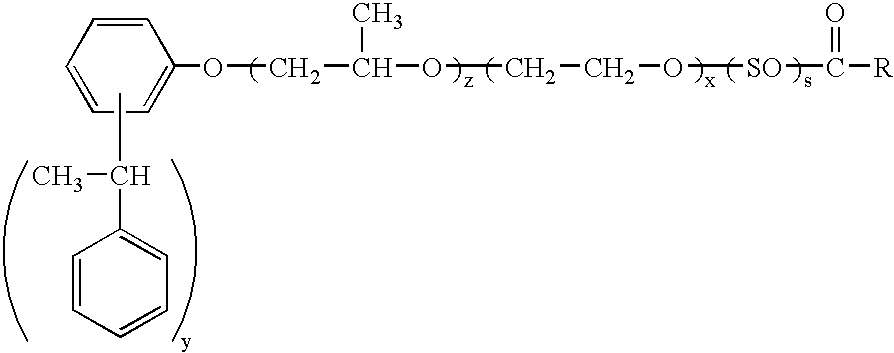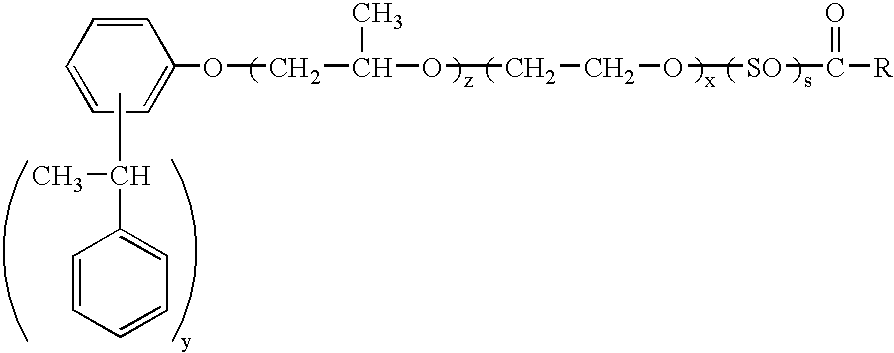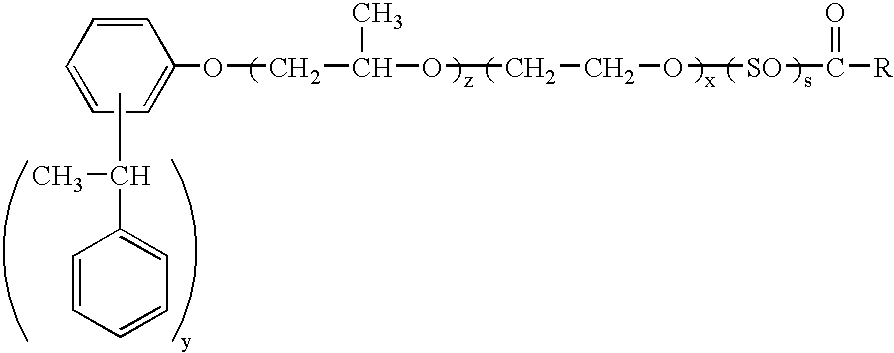Dispersions containing fatty acid esters of styrenated phenol alkoxylates
a technology of styrenated phenol and dispersions, which is applied in the direction of film/foil adhesives, inks, instruments, etc., can solve the problems of not being able to build in most cases, and requiring high mechanical forces to introduce solids into liquid media, etc., to achieve the effect of improving physical and chemical properties
- Summary
- Abstract
- Description
- Claims
- Application Information
AI Technical Summary
Benefits of technology
Problems solved by technology
Method used
Image
Examples
example 1
[0101]The amount of components as outlined below are used in the preparation of a coconut fatty acid ester x=9-18 and and y=2.0-2.3.
[0102]
COMPONENTAMOUNTEthox 2938 (anhydrous)161.3 gp-toluenesulfonic acid 0.5 gCoconut fatty acid 35 g
[0103]To a clean reactor, charge about 165 grams of the ETHOX 2938 so that after drying there will be approximately 161.3 lbs. of anhydrous material. Dry with N2 and heat to 110-120° C. to a water content % H2O<0.1%. When dry, cool to 80° C. Then add 35 g of p-toluenesulfonic acid and 0.5 g of coconut fatty acid and heat at 135-155° C. The reaction takes 20-28 hours and a product of the formula
[0104]
wherein y is about 2.0-2.5, x is about 9-18.
example 2
[0105]The following components are reacted using the procedure of Example 1.
[0106]
COMPONENTAMOUNTEthox 2938 (anhydrous) 82 gp-toluenesulfonic acid0.25 gCoconut fatty acid 18 g
[0107]The resulting product is a pale yellow liquid.
example 3
[0108]The following components are reacted using the procedure of Example 1.
[0109]
COMPONENTAMOUNTEthox 2938 (anhydrous)1610.3 gp-toluenesulfonic acid 5 gCoconut fatty acid 350 g
PUM
| Property | Measurement | Unit |
|---|---|---|
| diameters | aaaaa | aaaaa |
| diameters | aaaaa | aaaaa |
| diameters | aaaaa | aaaaa |
Abstract
Description
Claims
Application Information
 Login to View More
Login to View More - R&D
- Intellectual Property
- Life Sciences
- Materials
- Tech Scout
- Unparalleled Data Quality
- Higher Quality Content
- 60% Fewer Hallucinations
Browse by: Latest US Patents, China's latest patents, Technical Efficacy Thesaurus, Application Domain, Technology Topic, Popular Technical Reports.
© 2025 PatSnap. All rights reserved.Legal|Privacy policy|Modern Slavery Act Transparency Statement|Sitemap|About US| Contact US: help@patsnap.com



